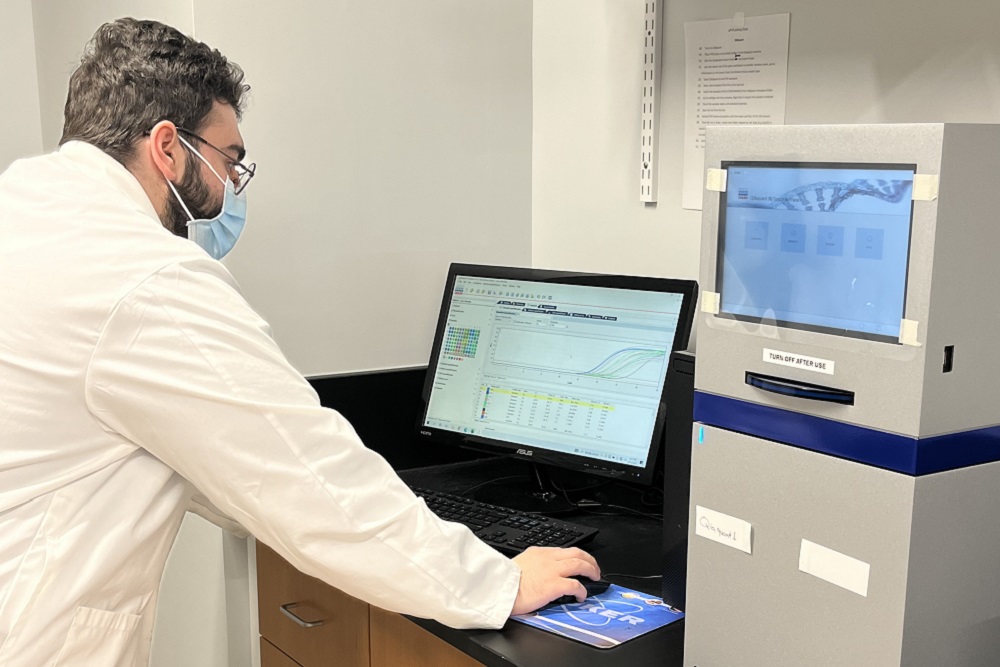Clean drinking water is a critical component for sustainable development – from poverty reduction to economic growth and environmental sustainability. Currently, according to the United Nations (UN) there is a global water crisis affecting almost 2.2 billion people who lack access to safe water. To raise awareness of the crisis and support the global work advancing Sustainable Development Goal 6: Clean Water and Sanitation the UN identified March 22 as World Water Day.
To learn more about innovations in water system infrastructure, the role of sanitation during the COVID-19 pandemic, and the improvements needed to provide equal access to clean water in Canada, the Gazette spoke with Queen’s researcher Sarah Jane Payne (Civil Engineering). An expert in emerging water contaminants and water quality management, Dr. Payne previously worked in the federal public service holding roles in water, wastewater, and environmental policy and regulation for Environment and Climate Change Canada and Health Canada. At Queen’s, she is Co-Lead of the Queen’s COVID-19 Wastewater Surveillance Initiative and Co-Director of the Drinking Water Quality Group (DWQG), an affiliated research program of the Contaminants of Emerging Concern-Research Excellence Network (CEC-REN).
Could you tell us more about the Drinking Water Quality Group and facilities such as the Drinking Water Distribution Lab (DWDL) at Queen’s and how they support your research?
Queen’s is home to two world-class facilities with labs at Mitchell Hall and the Drinking Water Distribution Lab (DWDL). In fact, DWDL is only one of two full-scale research facilities in the world and the only one in North America. When I started working at Queen’s, I quickly discovered that I had many complementary academic interests with DWDL’s lead Yves Filion (Civil Engineering). We formed the Drinking Water Quality Group as a way for us to envision and explore complex, collaborative, and interdisciplinary research, recruit students, and situate Queen’s at the centre for solving critical issues in the water industry.
Currently, the Group is focused on understanding and predicting drinking water quality deterioration and looking for ways to prevent it, specifically through analyzing utilities data collected for regulatory compliance purposes. The DWDL allows us to conduct research in a controlled environment and look at the causes of drinking water discolouration or the accumulation of contaminants on pipe walls and learn about the optimal ways to remove them. We can also conduct smaller scale experiments in Mitchell Hall that allows us to further isolate the key mechanisms. Combining all of this knowledge together, we plan to develop machine learning tools to help predict high risk areas for water quality deterioration. This type of artificial intelligence (AI) tool could allow utilities to optimize their resources by strategically targeting the right areas for maintenance or replacing problematic pipe materials.

What is something people may be surprised to know affects their local water quality and what actions could to be taken to minimize harmful effects?
The question I get asked the most is: do I drink tap water? I do! I am a tap water enthusiast, and I enjoy taste testing tap water in different cities. The challenge with local water quality is that the problems can be very localized and can even be specific to your home. Awareness of what issues you might encounter and knowing where to find resources to help is key.
My two biggest "local" water concerns are for private wells and lead service lines. Private wells can become contaminated and pose risks for users such as gastrointestinal illness. The most important thing owners can do is test their wells routinely for microbial contaminants. In Ontario, this water testing is free and there are several resources and actions owners can take to improve their well water quality if needed.
My other big worry is about lead exposure and its harmful effects for infants and children as a powerful neurotoxin. The largest sources of lead in drinking water come from building plumbing materials, such as the service line connecting the distribution system to your house (allowed until 1975), lead tin solder (allowed until 1986), and brass fittings that could contain up to 8 per cent lead (allowed until 2014). Depending on the age of the home, I advise people to connect with their local water utility to ask whether or not lead service lines are expected in their neighbourhood and to have their water tested if needed. If lead is present, there are several options for eliminating it or using a certified treatment device and flushing your taps every day.

How did you pivot your wastewater research to confront COVID-19? Your team has been working in partnership with Utilities Kingston, Loyalist Township, the City of Cornwall, and KFL&A Public Health to monitor trends in transmission locally, do you plan to build on your partnerships for future collaborations?
One my undergraduate students asked me if there was a connection between COVID-19 and wastewater. In searching for an answer, I read about some early and important proof-of-concept work out of the Netherlands that also suggested that SARS-CoV-2 wastewater surveillance could be both an early warning tool and non-invasive and inexpensive way to monitor the level of infection in a whole community. There was a lot of initial skepticism that it could be done at all, as detection is almost a needle in a very inhospitable haystack. However, through highly collaborative and open research endeavours provincially, nationally, and globally wastewater-based epidemiology has generated a whirlwind of scientific discovery and insight.
At Queen’s, Stephen Brown (Chemistry) and I lead an amazing team of post-doctoral fellows, technical staff, graduate, undergraduate, and summer students who are working tirelessly in the lab to hone this technique and explore its application possibilities. We have plans to advance wastewater-based epidemiology to monitor other viruses and bacteria as an early warning system for public health decision makers. We are also looking to optimize analysis for other targets and refine the technique as the applications expand.
Our utility and municipal partners are vital to this project and provide sample collection and operational expertise to interpreting sample quality issues. We share the data with our public health unit partners and it is used in their situation awareness and public resources, such as KFL&A Public Health’s COVID-19 in Wastewater dashboard. It is a privilege to do work that is helpful to public health decision makers and an honour to work with the talented people on our team, our partners, as well as our colleagues across Ontario, Canada, and around the world. This project to confront COVID-19 has been the most unexpected, challenging, collaborative, and also the most rewarding work of my career. I’m very excited about our future work together, and the opportunity to protect public health through advancing wastewater science and engineering research.
While Canada is a freshwater-rich country, many here to do not have access to safe and clean water, particularly in Indigenous communities. The federal government has identified water treatment systems and infrastructure as crucial investments with a significant focus on renovating and upgrading existing systems to expand access. What key innovations and developments do you think are needed to retrofit Canada’s ageing water infrastructure for a sustainable future?
For innovations and development, I think of two things. The first is a community-based approach to ensure that the infrastructure is what a community wants, needs, and can operate and maintain. The second is a fulsome definition of sustainability that ensures adequate funding for operation and maintenance, resources for the recruitment, training, and retaining of talent to operate and maintain that infrastructure, and that the infrastructure is robust, efficient, resilient, and climate change ready.
Water is essential to life, and it is a universal need. We need to value it, protect it, celebrate it, and make sure that we can all access it.

This article first appeared in its original form in the Queen's Gazette.